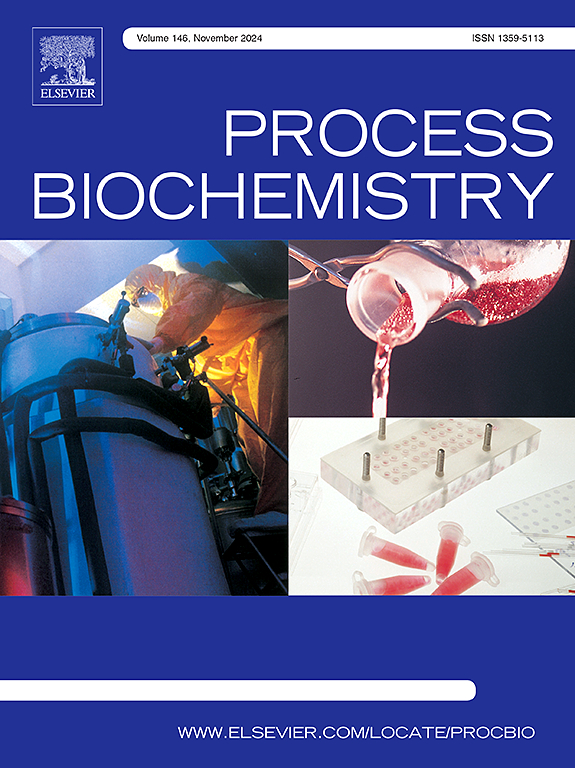发酵红曲霉生物量作为一种新的富含蛋白质的食品原料
IF 4
3区 生物学
Q2 BIOCHEMISTRY & MOLECULAR BIOLOGY
引用次数: 0
摘要
红曲霉是一种丝状真菌,以生产深红色酵母米而闻名,它不仅提供高蛋白含量,而且还提供生物活性化合物,如生物碱、酚类物质和类黄酮,这些物质具有抗氧化、抗炎和抗癌的特性。虽然传统上用作着色剂或膳食补充剂,但它尚未被开发为食物生物质。本研究利用固态发酵(SSF)和浸泡发酵(SmF)优化了紫红色分枝杆菌的生长条件,实现了SmF和SSF的生物量(干重)分别为6 g/L和4 g/L,蛋白质含量分别为35 %和21 %。氨基酸谱分析发现了6种必需氨基酸,其中赖氨酸含量最高。通过气相色谱-质谱联用(GC-MS)对所得生物质进行了表征,鉴定出SSF中有17种化合物,而SmF中有15种化合物,包括糠醛衍生物和脂肪酸。固态发酵和浸泡发酵产生的生物量抗氧化水平分别为3.65 ± 0.14和3.33 ± 0.10 mmol TE/100 g。这项工作强调了紫红色分枝杆菌生物质在食品配方中的潜力,在没有外部添加剂的情况下提供乳化性能,尽管在胶凝和发泡能力方面存在局限性。本研究确立了紫分枝杆菌作为一种可行的替代蛋白质,为可持续粮食系统和促进全球粮食安全做出贡献。本文章由计算机程序翻译,如有差异,请以英文原文为准。
Fermentation of Monascus purpureus biomass as a new protein-rich food ingredient
Monascus purpureus, a filamentous fungus known for producing crimson yeast rice, offers not only high protein content but also bioactive compounds, such as alkaloids, phenols, and flavonoids, which provide antioxidant, anti-inflammatory, and anticancer properties. Although traditionally used as a colorant or dietary supplement, it has not been exploited as food biomass. This study optimized growth conditions for M. purpureus using solid state (SSF) and submerged-state fermentation (SmF), achieving biomass yields (dry weight) of 6 g/L in SmF and 4 g/L in SSF, with protein contents of 35 % and 21 %, respectively. Amino acid profiling revealed six essential amino acids, with lysine as the most abundant. The obtained biomass was characterized by gas chromatography coupled to mass spectrometry (GC–MS), identifying 17 compounds in SSF compared to 15 in SmF, including furfural derivatives, and fatty acids. Solid-state and submerged-state fermentation produced biomass with antioxidant levels (3.65 ± 0.14 vs. 3.33 ± 0.10 mmol TE/100 g, respectively). This work highlights the potential of M. purpureus biomass in food formulations, providing emulsifying properties without external additives, although with limitations in gelling and foaming capacities. This research establishes M. purpureus as a viable alternative protein, contributing to a sustainable food system and advancing global food security.
求助全文
通过发布文献求助,成功后即可免费获取论文全文。
去求助
来源期刊

Process Biochemistry
生物-工程:化工
CiteScore
8.30
自引率
4.50%
发文量
374
审稿时长
53 days
期刊介绍:
Process Biochemistry is an application-orientated research journal devoted to reporting advances with originality and novelty, in the science and technology of the processes involving bioactive molecules and living organisms. These processes concern the production of useful metabolites or materials, or the removal of toxic compounds using tools and methods of current biology and engineering. Its main areas of interest include novel bioprocesses and enabling technologies (such as nanobiotechnology, tissue engineering, directed evolution, metabolic engineering, systems biology, and synthetic biology) applicable in food (nutraceutical), healthcare (medical, pharmaceutical, cosmetic), energy (biofuels), environmental, and biorefinery industries and their underlying biological and engineering principles.
 求助内容:
求助内容: 应助结果提醒方式:
应助结果提醒方式:


